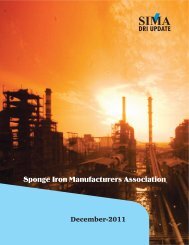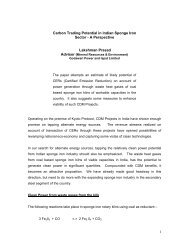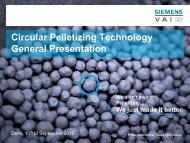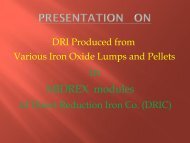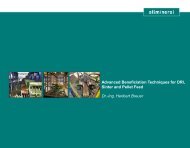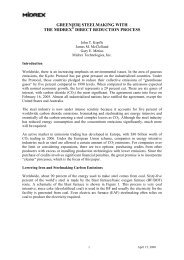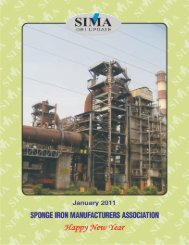You also want an ePaper? Increase the reach of your titles
YUMPU automatically turns print PDFs into web optimized ePapers that Google loves.
Figure 5<br />
FASTMET Plant at Nippon Steel<br />
Hirohata Works (1 of 2)<br />
Expected operating parameters for FASTMET and<br />
FASTMELT Plants in India are given in Table II.<br />
Table II<br />
FASTMET/FASTMELT Plants<br />
Operating Consumptions for Indian Conditions<br />
Basis: Production rate of 500,000 tpy<br />
Quantity per t of product<br />
FASTMET FASTMELT<br />
Input Units DRI hot metal3<br />
Iron Ore1 t 1.4 1.4<br />
Coal2 t 0.4 0.4<br />
Lime (binder) kg 60 60<br />
Flux t - 0.04<br />
Burner fuel net Gcal 0.7 0.7<br />
Electricity kWh 100 575<br />
Labor man-hour 0.2 0.35<br />
Maintenance USD 5.00 10.00<br />
1. Assumes DR-grade iron oxide; consumption of<br />
wastes with lower iron content would be<br />
proportionally higher<br />
2. <strong>May</strong> be lower if wastes are used that contain<br />
carbon<br />
3. Quantities for FASTMELT include RHF and EIF<br />
The advantages of FASTMET and FASTMELT<br />
include:<br />
Uses well-proven RHF Technology<br />
Ability to use domestic iron ore fines and ironbearing<br />
wastes<br />
Uses fine, non-coking coals; carbon–containing<br />
wastes reduce coal required<br />
Larger capacities than rotary kilns: up to<br />
500,000 tpy in a single module<br />
FASTMET DRI can be melted in an EAF or BOF<br />
FASTMELT produces a high quality hot metal<br />
Midrex and Kobe Steel are now discussing FASTMET<br />
and FASTMELT plants with a number of prospective<br />
clients around the world. Potential applications are<br />
regional treatment facilities, which would receive<br />
wastes from local steel mills, and use at a mine site<br />
to treat stockpiled mine tailings.<br />
Conclusion<br />
Indian steel production will need to continue to grow<br />
to supply the country’s rapidly expanding economy,<br />
utilising the country’s indigenous wealth of iron ore<br />
and coal. The blast furnace/BOF steelmaking route<br />
will continue to play a role, but it has limitations, such<br />
as the need to import expensive coking coal, the<br />
higher capital cost, and environmental issues. Direct<br />
reduction will continue to grow, but there are<br />
limitations with respect to the current approaches.<br />
Rotary kilns are small-scale and produce a lower<br />
quality DRI. The availability of natural gas to feed<br />
the larger capacity shaft furnace DR plants, is limited.<br />
Two new approaches that can make use of Indian<br />
resources are Gasification/MIDREX and the rotary<br />
hearth technologies FASTMET and FASTMELT. Coal<br />
gasification using the S-L FBDB Gasification Process<br />
and the MIDREX Shaft Furnace are individually wellproven<br />
worldwide and if combined, can provide an<br />
economical way to make high quality steels using<br />
Indian iron ores and coals. FASTMET on the other<br />
hand, provides the opportunity to recycle ironbearing<br />
wastes and solve an environmental problem.<br />
FASTMELT can utilize Indian iron ore fines to<br />
produce a blast furnace-grade hot metal.<br />
MAY-<strong>2007</strong>/6



